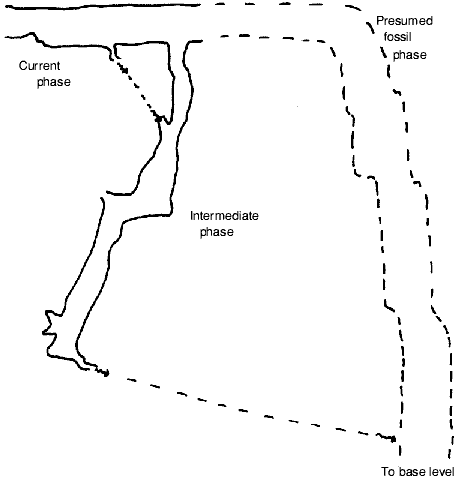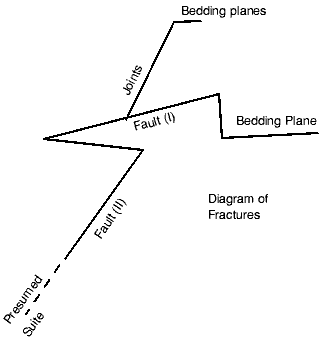
(GSAB) Spéalp 2 (1978) pp 14-19
The summer GSAB expedition to the Totes Gebirge has allowed the exploration of this new cave of 565m depth. Certainly, it is a little eclipsed by its two neighbours (Kelli and Empégadure) but it remains no less of an accomplishment for a young team, only just broken into their first large-scale trip.
For the location and discovery details, see the report in Spéalp GSAB-SSS number 1.
The entrance, a bedding plane unblocked because of a draught, gives access to a series of short pitches, dry at the start, which get bigger, deeper, wider and wetter. The first exploration of 1976 had reconnoitred to -200m to the base of a 40m pitch (The Black Hole). The explorers of this year started on the descent of a fine 60m pitch of constant shape, slightly sloping. At the bottom of this is the only chamber of the cave : The Galactic Hall. Here the cave splits into two routes, the active and the fossil.
Downstream from the chamber a drop leads to a small chamber among boulders, the Love Nest. (No idea who ventured to call it this[?]) Between the boulders a 20m pitch opens, immediately followed by a 25m pitch. In fact, the last 25m of descent drops between the walls of an immense aven to land on a flat gravel floor. A diagonal chimney leads to a trickle of water.
A fissure marks the start of the Anti-matter meander, where one immediately rejoins the underground stream. This has an average flow of two litres per second but quite rapidly increases to 10-15 litres per second in flood. The first part of the meander is straight and interrupted by 3 small pitches and two drops. At the top of the first, in the roof, is the connection with the fossil system. Quickly, the meander becomes less amenable: high and narrow, it is plastered with mud (the anti-matter) which makes progress quite arduous. Three pitches of 5, 14 and 10, punctuate progress. This last, followed by a drop of 3m, gives access to a section of passage blocked by clay. At the end of this, the stream disappers into a fissure with tight impenetrable bends. The passage is continued by a quite large fossil branch. After some 50m, the draught goes into an earthy hole, the start of a big pitch of 70m in several stages.
Halfway down, the pitch is rejoined by the stream which is avoided by a parallel fossil pitch. There immediately follows another pitch of 55m, totally wet and characterised by an elliptical cross-section and constant slope. At the bottom, the water is engulfed by a fissure about three metres long, followed by a tight meander which we haven't pushed.
Upstream from the Galactic Hall, a window some metres high gives access to a good-sized passage (3x3m on average), the Little Green Men's passage. One comes up against a climb of 3m at the base of which the trickle of water is lost into a meander cut below the fossil passage (see below). After a narrowing and a climb, the passage ends in boulders between which it is still possible to penetrate for a dozen metres.
Back in the meander below the fossil passage: this ends at the Gomette pitch (discovered by the Gaumais), a 60m pitch, spray-lashed in its lower part by "the wee-wee". At the base of this pitch is the beginning of the Mutants' meander. This is a passage for masochists par excellence: at the bottom, tight and suit-snagging. It ends in a series of climbs and a 30m pitch joining the active system.
From the geological point of view, the Gouffre Ovni is a typical example of the karstic phenomena of the massif, and likewise of the greater part of the karst of Austria. There isn't a zone of pitches leading to a master-cave on an impermeable bed (of the Pyrenean type) nor tight vertical caves (of the Vercors or Chartreuse type). The primary factors in the formation are the intense orogenic fracturing combined with a very wet climate and heavy snow-falls since the start of the era.
These caves generally open by virtue of the simple form of the discontinuities in the limestones (joints, bedding-planes). Then they enlarge more and more by following the larger-scale phenomena (faults, master-joints). The master-cave, when it exists, is generally only short and near the resurgence.
The entrance is in a bedding plane open for about two metres. There follows a series of pitches, quite small, formed in a quite sinuous joint and enlarged on bedding planes and very strong [pendage - dictionary failure] in this zone. At about -200m, the influence of another factor starts to be felt. The pitches become bigger and bigger and the walls cleaner and cleaner. This section is characterised by a fault running roughly East-West (see figure 1).

This fault controls the major part of the formation of the cave. In effect, the course of the cave is hollowed out of different levels of this fault. (figure 2)

Figure 2: Plan of the fault
Following the large part of the Anti-matter meander, a very narrow zone marks the junction with a second fault orientated SE-NW which controls the rest of the cave. [next sentence is real gobbledegook to me unless there is a misprint in the french ?] One rotted to believe conspicuously the survey, which concerns a meander in a joint seen its sinuosity [???]. In fact, the straight part and space of this fault is impracticable because it overhangs continually a perpendicular of 6m whence the lips are sloping and muddy. One is therefore obliged to borrow the bottom in [surcreusement - what a time for a dictionary failure !]. More unwavering [lots of alternative translations for this word - none make much sense] by an unhooking where the stream destroys itself [sinks ?]. The passage continues in the same direction always controlled by the jointing/faulting. The zone of pitches which follows develops equally in the lower part of the fault; [elle ait is the present subjunctive of avoir - what the fuck does present subjunctive translate as ?] well what/as/who/as/how has the appearance of a forced conduit [phreatic passage/lift ?]
As one the remark to the observation of the survey, the main passage continues unexplored. It appears that [present subjunctive of to be] in the presence of a simple phenomenon of regression and so logically one should find another series of fossil pitches dropping to the base level. (figures 3 and 4)


The strength [power, force ?] of the Dachsteinkalk (granular Jurassic limestone) lies next to the 700m from the entrance. [??]

Figure 5: Diagram of the draughts at the principal points of perception:
As we have already said, there is a strong draught which drew our attention to Ovni. This draught was blowing in a hot period (summer) [so] we logically [expected] to find the presence of an intermediate entrance. Seeing the strength of the cold draught [chassé], the existence of an upper entrance is fairly certain. Prospecting on the hillock above the entrance didn't yield results. It concerns there of an objective to see again because the vegetation and the snakes didn't permit us to operate an efficient search pattern.
The junction with this higher entrance must be at the level of the Little Green Men's passage; either by the wet chimney at the bottom of the 1st fault or in the roof of 2/3, there where the draught is lost. For the other part, the presence at the bottom of another strong draught, suggests a lower entrance, probably a fossil resurgence. Nevertheless these are only suppositions, the caprices of a draught are very difficult to deal with.
One sees from this brief analysis of the cave that the chances of a continuation aren't minimal. Now this cave isn't extremely difficult of access or of exploration. The work [god knows - rotted to be there mend] very soon, but it is nevertheless a secondary objective compared with other Austrian possibilities.
G Feller GSAB